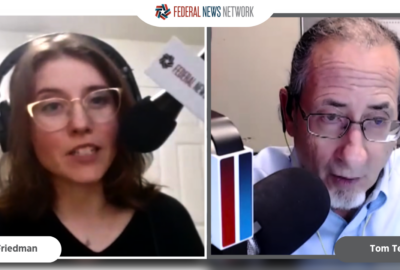This HHS operative is taking on high and complicated hospital bills
This guest is 35 years old and joined federal service only three years ago. She's having a big impact in a lot of ways having to do with health care delivery.
This guest is 35 years old and joined federal service only three years ago. But she’s having a big impact in a lot of ways having to do with health care delivery. She’s the chief digital strategy officer for the Centers for Medicare and Medicaid Services and a finalist in this year’s Service to America Medals program. Andrea Fletcher shares more on the Federal Drive with Tom Temin.
Interview Transcript:
Tom Temin
The Chief Digital Strategy Officer sounds like a big job for a place as big as CMS. What do you do there exactly?Andrea Fletcher
That’s a great question. My official title has a lot in it. So I lead the digital service team at CMS, which is a team of technologists who are coming in on a tour of service very similar to how the US digital service functions. But CMS is so big that we actually have our own team. We sit in the office of the administrator, and different groups across CMS will call us when they’re having a technology problem or they’re stuck. And they need some help or kind of like a consultation, fix it team. So sometimes we’ll scrub in and we’ll actually write code. Sometimes we’ll go do user research, often we’re working on stuff that is moving so fast that we don’t really have enough time to plan years out in advance. We’ve got to fix it quickly. And so that’s what my team does. I have data scientist, product managers, software engineers, designers and user researchers and people who are very skilled. And they’re wonderful to work with.Tom Temin
When you think in terms of the digital experience. Who do you envision as the customer?Andrea Fletcher
That’s a great question, because there’s a lot of people who are our customers. So we serve 160 million Americans directly through programs or so Medicare, which is generally people over 65. There’s somewhere around 64 million people in it now, we signed 10,000 people up a day into Medicare 10,000 people a day. Medicare is the largest health insurance provider in the world, it is a huge claims processing behemoth. It’s a large portion of the US healthcare system. So one customer, our Medicare beneficiaries. And then also I think a key part of that are healthcare providers. So hospitals and doctors and clinicians who are providing services to the Medicare beneficiaries. We’re responsible for making sure that health care is high quality as well.Tom Temin
And your citation for your Sammies award mentioned the fact that you have shed light into incomprehensible medical bills that people receive. How does that relate to digital services? Just tell us what you did there?Andrea Fletcher
There have been a couple of laws that have been passed recently that CMS has been working on implementing, particularly the No Surprises Act, which passed in I believe it was 2021, or 2020, which is about surprise medical billing. I’ve gotten surprise medical bills, I don’t know anyone who hasn’t, where you get a bill and you don’t understand it. And I have a husband who actually has had surgery recently. And we were sitting around the kitchen table with a stack of bills and a stack of explanations of benefits, trying to figure out what do we owe? What’s the coinsurance? What’s the copay? There’s a lot of terms that you don’t really realize what you’re signing up for, I think when you sign up for health insurance. And you’re trying to make a decision on how much you can afford each month, but then if something happens, you’re also paying out of pocket for that. And so the no surprises act is to help eliminate mostly out of network bills and those traditional surprise medical bills.But a lot of the work that we ended up doing was just talking to people about bills, and trying to understand what does the average American do when they get a bill that they don’t understand? Where do they go? What help do they need? How do we as the federal government, provide them information on to be a smarter consumer to understand what they’re purchasing when they purchase health insurance? But also to understand that bill, if they can’t pay it, where do I go? Where’s their help? What are my options? And so we built an entire portion of cms.gov. It’s called medical bill rights to support advocacy groups who are working with people and navigators who are helping people navigate the healthcare system, as well as some new forms for people who are uninsured who are going to dispute medical bills. So a bunch of work around No Surprises Act, and then some additional work around the hospital price transparency role, which is to help hospitals post their prices and machine readable format. Again, this is all, it’s very complicated how pricing works in the healthcare system. It’s not a really straightforward process from my learning and understanding of it. And I think it’s just a really common experience for people to be sitting at the kitchen table trying to figure out what they owe. And one user said to us, the math ain’t mathing. It just doesn’t add up.
Tom Temin
We’re speaking with Andrea Fletcher, she is Chief Digital Strategy Officer for the Centers for Medicare and Medicaid Services, and a finalist in this year’s Service to America Medals program. And well, as we said at the outset, you’re 35, you’ve been in the government for only three years. What did you do before government?Andrea Fletcher
I’ve always worked with governments, but I spent the first part of my career in Sub Saharan Africa. So I worked on health information systems in other countries. I lived in South Africa, in Malawi, Kenya. So I worked a lot on HIV and Ebola and public health data systems. And how do we get the information that we need from the clinician or the point of service patient to president is what we used to say a lot, which is the decision makers along the line who need to determine where are we going to put resources? Where are we going to put more nurses? Where do we need to do test kits for HIV? What are our strategies? And all of that relies on really good public health data? So I spent most of my career working on public health data systems implementation of electronic health record systems, basically understanding how information flows through healthcare systems. And now I’m doing that domestically, which is a bit of a shift for me personally, because I’ve almost always worked in a global health context or abroad. And it’s really fascinating to see the American healthcare system, which is incredibly complex and incredibly large, and a huge portion of the US economy. So it’s a really important role and a really important system to really think through how does data and information flow through the US healthcare system?Tom Temin
Yes, that idea of complexity, I think, is apparent to anyone who’s ever had to have a tooth pulled or anything, and let alone major surgery. And do you think about ways that this could be fundamentally simplified? Because every time you go for an appointment, you see the way places operate, even layman figures, there’s got to be something fundamentally simpler than the way this is happening right now.Andrea Fletcher
Yeah, I think we think a lot about, and it’s back to the basic building blocks. I’ve worked on healthcare data standards for almost a decade now and implementing data standards and how we share data across electronic health record systems. And we call it interoperability or integration of systems. There’s a lot of new policy that has come out in the last, I would say, two to five years that should help improve a lot of that. I also look at were all carrying smartphones around in our pockets, and I have so much information on my smartphone. But realistically, like healthcare information is not that accessible to the average person. And we’re getting better. I think there’s a lot of movement in the right direction. CMS in particular, has launched some of the largest open source API’s of application program interfaces. It’s called Bulk FHIR, its the healthcare interoperability standard. And so we have these huge ways of opening up Medicare data. And we’re CMS goes to the rest of the healthcare system tends to follow. We’re a pretty big leader in areas like this. And that’s been a big push, that’s been been a huge push on my team. From the data teams across CMS is how do we build a more transparent, open information flow in the US healthcare system?Tom Temin
And as someone who is on the younger side, and also new in government, what is it like? CMS almost personifies bureaucracy, sprawl, and bigness. Can someone like you thrive in a place and bust through all of that?Andrea Fletcher
I’m living proof that you can. I hope I make it to Medicare someday. Medicare is one of the greatest programs that we’ve ever implemented as a country, it’s fantastic. It helps so many people get the health care that they need, when they need it the most. And the same with Medicaid. And I look at the federal government, the bureaucracy can be tough, I’ll be honest. Sometimes you have to cut through red tape, and it can take you longer than you wanted it to. But Medicare, in particular, CMS has really become tech forward, in my opinion, and leaned into technology as an opportunity to deliver a better customer experience, and to deliver better services for the American people. And it’s a pretty exciting time to be like a young technologist in the government, because we’re starting to rethink the way that we build software and deliver services. And I think COVID-19 had a lot to do with this. All of the sudden people couldn’t go physically to their social security office to ask questions about their Medicare benefits, and they had to go online. And so we needed to rethink the way that we’re providing services online. We needed to rethink the information that we’re providing and how people access information. And to me if there’s a little bit of a revolution happening, I think across the federal government, but also within CMS of well, ok, this is the way we’re going to do things now. So how do we do it. In a world class technology country, we’re one of the strongest countries in the world when it comes to delivering software. How do we do that within the government?
Copyright © 2025 Federal News Network. All rights reserved. This website is not intended for users located within the European Economic Area.
Tom Temin is host of the Federal Drive and has been providing insight on federal technology and management issues for more than 30 years.
Follow @tteminWFED






